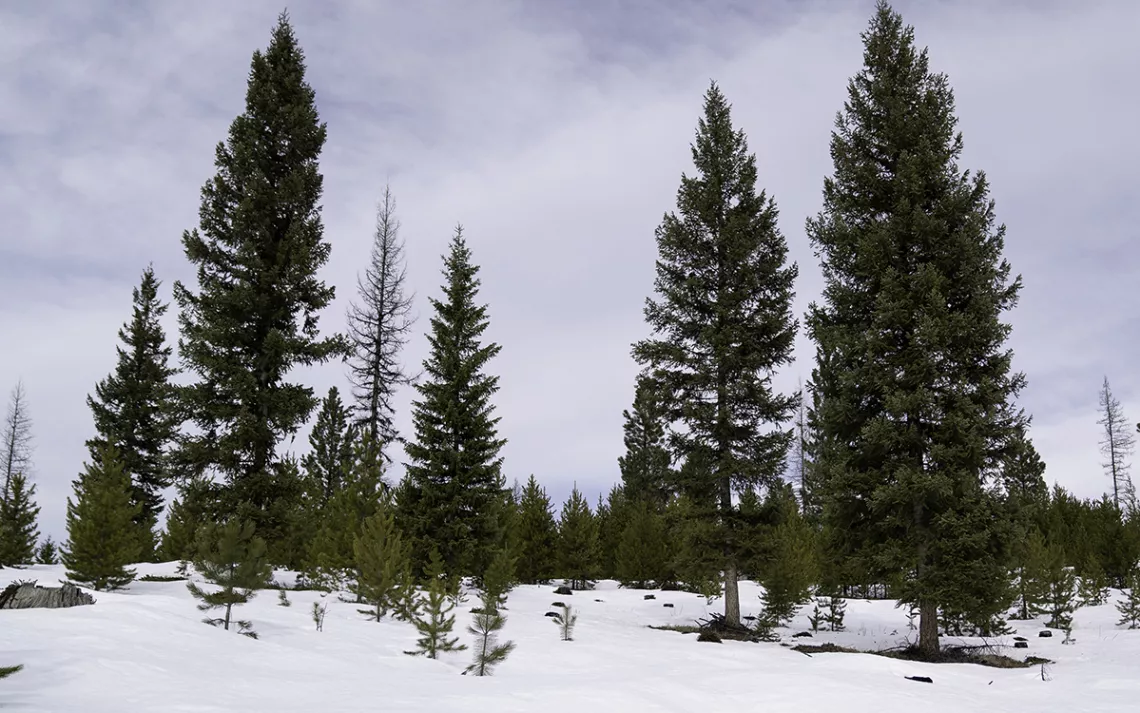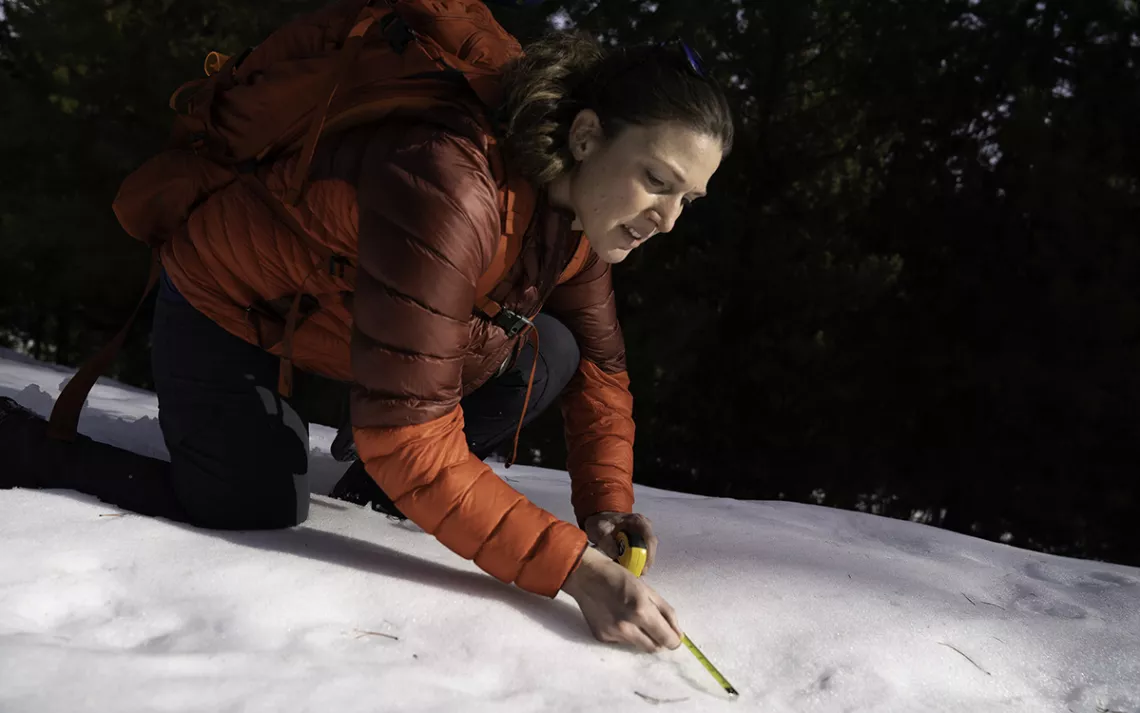Researchers Are Using eDNA to Track Lynx, Wolverines, and More
Environmental DNA in snow tracks can help conservationists find and study rare carnivores

Photos by Sierra Cistone
The round pawprints of an unknown animal led up a snow-covered road in western Montana’s Lolo National Forest. Jessie Golding bent to inspect the tracks, then walked slowly alongside the trail, leaving Bigfoot-size snowshoe prints behind as she went. It was an unseasonably warm day for early February; the sun had ebbed away at the animal’s tracks until all that was left were circular imprints. Golding took a guess at their origin: Canada lynx. She dropped her pack, put on a fresh pair of disposable gloves, and began scooping the snow out of the tracks into a clean plastic bag. In the snow, there was an invisible breadcrumb Golding would later use to uncover the animal’s identity: environmental DNA.
Golding is the leader of the Multispecies Mesocarnivore Monitoring Program for the US Forest Service’s National Genomics Center and Northern Region. For the past five years, she has been developing this novel method of using environmental DNA, or eDNA, found in snow tracks to identify rare forest carnivore species including Canada lynx, wolverines, fishers, martens, and montane red foxes. These species live throughout the forests of western Montana and northern Idaho but are characteristically elusive.
The secretive nature of these animals makes it difficult for researchers to monitor how their populations are faring. But Golding and her colleagues can use eDNA from tracks in the snow to identify the presence of these species in order to better understand where they exist. “The first step in being able to conserve a species is knowing where they are,” Golding says. “And you would be surprised how often we don’t know that.”
The eDNA comes from the paws of an individual animal and can be in the form of skin cells or secretions from scent glands. When the animal steps in the snow, it leaves behind this genetic material. While searching for food, a lynx can lay down over five miles of tracks in one day; a wolverine can lay down even more. The constant movement of these animals in the winter means tracks are a ubiquitous part of these snowy landscapes.
The process for monitoring rare carnivores has traditionally relied on visually identifying tracks in the field and following the tracks to a place where the animal has killed prey, fed, or left scat. Kill sites and scat also contain DNA that is used to identify the species of carnivore. Another common method is to set up “bait stations,” which lure the animals in with already dead prey. Small wire-haired brushes will be set up near the bait to snag hairs from the animal as another way to get DNA samples. But these monitoring methods can be labor-intensive and time-consuming.

Collecting eDNA samples, however, is quick and easy, says Golding. The main concern is to make sure that each sample is collected without any contamination. This is accomplished with fresh gloves, new bags, and sterilized equipment for each sample. Once she has a bag of scooped snow from a track, the sample is kept frozen until it is ready to be run through the lab. A positive detection of a species can be determined from tracks that are weeks old, and a single strand of DNA is all that’s needed.
Identifying rare carnivores from eDNA in their tracks initially seemed like a long shot to Golding. She first applied the method in Beaverhead-Deerlodge National Forest, where Canada lynx were not known to be found. But in 2018, a private citizen had captured a picture on a remote-sensing camera, and the photo looked curiously like a lynx. The ambiguous picture inspired the first test to see if the eDNA method could help confirm what the camera couldn’t.
Not knowing how much snow would be needed to find eDNA, Golding remembers collecting many gallons of it from the camera trap’s location and lugging it from the forest. To Golding’s surprise, somewhere in those gallons of snow was eDNA from a lynx. It was a game-changer.
Canada lynx are listed as threatened with extinction under the Endangered Species Act. This means that wherever they are found, land managers are required to consider how decisions will impact the species, explains Scott Jackson, the Forest Service’s National Carnivore Program leader. To be able to hunt, reproduce, and survive, lynx require diverse forests with young and old stands of trees. But good lynx habitat can easily be spoiled by uninformed decisions about forest management such as where to log or conduct prescribed burns. “The more we know about which species may live on this piece of ground, the more informed our management decisions will be,” Jackson says.
Despite how important this fundamental data is, it is often lacking for these species in their Rocky Mountain ranges. But as climate change continues to alter the habitat that these rare species depend on, it will be imperative to know as much as possible about their whereabouts and how healthy their populations are.
Environmental DNA can make gathering that information a more efficient process, says Betsy Herrmann, the planning and resources staff officer for Beaverhead-Deerlodge National Forest. Because collecting snow tracks is so simple, Herrmann has involved people in her department other than researchers to help with the efforts. Now, when Forest Service law enforcement officers and recreation specialists come across supposed rare carnivore tracks, they are trained to collect the DNA. More people involved in the monitoring process has meant covering more ground, Herrmann says.
Golding would like to see this method of wildlife monitoring someday expanded to a citizen science effort. Visually identifying tracks in the snow can be difficult or impossible, Golding explains. But eDNA is a powerful tool for identifying where the mountains’ most mysterious species have been out walking. “I always tell my team, ‘If you have any doubt, just scoop the snow,’” Golding says.
 The Magazine of The Sierra Club
The Magazine of The Sierra Club



